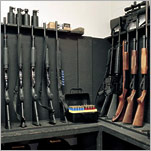DR. NATHANIEL SIMS, an anesthesiologist at Massachusetts General Hospital, has figured out a few ways to help save patients’ lives.

Eric von Hippel of M.I.T., left, and Dr. Nathaniel Sims, with hospital devices Dr. Sims has modified. Mr. von Hippel says users can improve on products.
Podcast
Weekend Business
This week: The Fed's intentions, gambling in Macao, shrinking restaurant meals, and investing in a rocky market.
- How to Subscribe
 This Week’s Podcast (mp3)
This Week’s Podcast (mp3)
In doing so, he also represents a significant untapped vein of innovation for companies.
Dr. Sims has picked up more than 10 patents for medical devices over his career. He ginned up a way to more easily shuttle around the dozen or more monitors and drug-delivery devices attached to any cardiac patient after surgery, with a device known around the hospital as the “Nat Rack.”
His best innovation to date, he says, involved modifying a drug infusion pump routinely used in hospitals to dispense the proper doses of medicine. Dr. Sims, an accomplished pilot, noticed in the mid-1980s that he could obtain navigation information from regularly updated databases. He wondered why doctors couldn’t use a device preprogrammed with the necessary data to figure out dosages themselves. From 1987 to 1992, he and a small team built an electronic device that worked with an existing pump to provide patients with the correct does of the proper drug. Alaris Medical Systems was the first established medical supply firm to use the technology.
David L. Schlotterbeck, the chief executive of Alaris, bet the company on the device. It was a good wager. The smart pump now brings in $700 million in sales — more than Alaris’s overall revenue of $534 million in 2003, the year before the company was sold to Cardinal Health.
What Dr. Sims did is called user-driven innovation by Eric von Hippel, a professor at the Massachusetts Institute of Technology’s Sloan School of Management. Mr. von Hippel is the leading advocate of the value of letting users of products modify them or improve them, because they may come up with changes that manufacturers never considered. He thinks that this could help companies develop products more quickly and inexpensively than with their internal design teams.
“It could drive manufacturers out of the design space,” Mr. von Hippel says.
It is a difficult idea for research and development departments to accept, but one of his studies found that 82 percent of new capabilities for scientific instruments like electron microscopes were developed by users.
Citizen product design is still unsung, but it has already become a force in software, especially gaming software. “Counter-Strike,” a player-created “mod” (for modification to the original game) of “Half-Life,” became as popular as the original game. Apache, the popular open-source Web server software, or the Firefox Internet browser, with its thousands of add-ons and plug-ins, also depend on users to develop innovations. Large companies like I.B.M. are increasingly turning to open-source techniques in their own software development.
It may also drive economic growth, Mr. von Hippel says. While Dr. Sims has no interest in starting a company, many people like him will do exactly that. Burton Snowboards, for instance, grew out of modifications that Jake Burton Carpenter made to a product called the Snurfer. He added a binding for the feet so that Snurfer riders no longer had to guide it by a rope on its nose.
SawStop makes a table saw that automatically stops within five milliseconds when it comes into contact with a user’s finger or thumb. The blade leaves the user with a small nick or cut, but the digit remains intact. It was invented by Stephen Gass, a patent lawyer who liked woodworking and thought that making a table saw safer was an interesting challenge.
One problem with the user-innovation model is that it can run into intellectual property rights protections. But the potential for creating new companies has led the government of Denmark to establish user-driven innovation as a policy. It found that Danish companies tended not to push for technological innovation, so user innovation may be the way to help them compete more effectively in a global economy.
Denmark may be the perfect testing ground for citizen product design, says Christopher Lettl, who six months ago left his native Germany to become professor of user-driven innovation at the University of Aarhus School of Business in Denmark. He thinks that Danish culture’s focus on the concept of “janteloven,” which holds that no person is better than another, may make companies more open to ideas from their users. The Danish company Lego is famous for tapping customers to help develop its Mindstorms NXT robotics kit.
Skeptics argue that Denmark is both small — population, 5.4 million — and a backwater of innovation, and thus has little to lose in trying something new. They might also point out that even in Denmark, Mr. von Hippel’s ideas are up against more conventional forms of user-aided design, such as sending anthropologists to study how people use products in their daily lives. Companies then translate their research into new designs.
Even some of Mr. von Hippel’s acolytes remain cautious. “A lot of this is still in the category of, ‘You could imagine this working out really well,’ ” says Saul T. Griffith, who as an M.I.T. engineering student was part of a group of kite-surfers who developed products for their sport that have since become commercialized. Mr. von Hippel wrote about Mr. Griffith in his 2005 book, “Democratizing Innovation.”
Still, Mr. Griffith can cite a long tradition of user design. One of his favorite examples comes from the title article in Tom Wolfe’s 1965 book, “The Kandy-Kolored Tangerine-Flake Streamline Baby,” which chronicled car customizers whose innovations — tailfins, double headlights, low-slung bodies — were later adopted by Detroit. Mr. Griffith says that even now, millions of people modify their cars, far more people than the world’s automakers could ever employ in research and development.
There is currently no effective way for companies to harness the ideas of those millions. But the Web — itself created by Tim Berners-Lee, an Internet user looking to do something new — seems to offer an excellent potential idea-gatherer. Mr. Griffith’s industrial design firm, Squid Labs, last year spun off a do-it-yourself community site on the Web called the Instructables, which features items as diverse as the Minty Boost iPod power source, dachshund wheelchairs and guns made entirely of K’nex toys, along with detailed instructions on how to build them. The Instructables intends to offer software to companies that want to build communities of citizen product developers.
Mr. von Hippel, who has spent 30 years waiting for his ideas to take hold, says that as user communities like the Instructables spread, they will dominate innovation. He calls them “the dark matter of innovation.”
User-driven innovation may still be in its infancy, but it is clear that companies should keep an eye open to whether something is rosy in the state of Denmark.
















